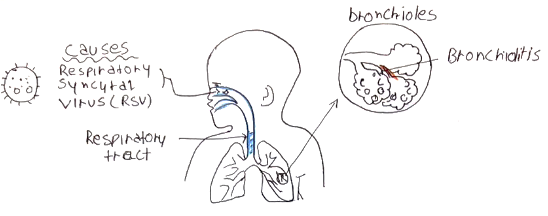Bronchiolitis
This is a lower respiratory tract infection which leads to the blockage of small airway in the lungs
– It can lead to significant respiratory distress, especially in children with other comorbidities such as prematurity, congenital heart disease or immunodeficiency.
– It is most seen in children younger than 2 and cases spike in autumn and winter
Cause:
Respiratory syncytial virus (most common), rhinovirus is second most common cause

Symptoms:
– General –> coryza, fever, irritability, poor feeding
– Dry cough
– Coryzal symptoms precede
– Wheeze and crackles on auscultation
– Respiratory distress –> chest wall recession, nasal flaring
– May experience pauses in breathing
Investigations:
– Usually made by clinical diagnosis
– Chest x-ray can be used to exclude pneumonia
– Immunofluorescence of nasopharyngeal secretions may show RSV, but this has little effect on management
Management:
– This is largely supportive and based on symptomatic management and most cases self-resolve
– Nutritional support, fluids, and oxygen therapy if low oxygen saturations
– If Apnoea (stop breathing), cyanosis, RR>70breaths/minute, SpO2 <92% –> admit to hospital
Prevention:
– Palivizumab (monoclonal antibody), can be given to infants who are at high risk of severe infection. This includes children with underlying heart/lung disease and premature babies.
Croup
This is an infection of the upper airway seen in infants and toddlers, known as laryngotracheobronchitis.
– Common infection particularly in the autumn months, affecting young children less than 3 years old
Cause:
Usually due to a virus –> parainfluenza virus in the most common cause
Symptoms:
– Inspiratory Stridor and hoarseness
– Barking cough (worsening during the night)
– Hoover’s sign: chest wall recession
– High fever, cold symptoms
Grading Severity of Croup
Management:
As similar to epiglottis, it is first necessary to rule this out.
– If mild illness –> give oral dexamethasone (0.15mg/kg) and symptoms usually resolve in 28 hours
– If moderate, severe, or <6 months age or known upper airway abnormality –> admit to hospital and give oxygen and nebulised adrenaline
Acute epiglottitis
This refers to inflammation of the epiglottis, which is caused by bacteria Haemophilus Influenzae type B
– It needs to be recognised and treated quickly as it can lead to airway obstruction
– It usually presents in children, but Haemophilus Influenzae type B vaccination has meant that it is rare and now is increasingly more seen in adults
– When diagnosing do not examine the throat due to risk of airway obstruction
Symptoms:
– Rapid onset high fever and malaise
– Drooling of saliva
– Muffled voice –> due to very sore throat
– Inspiratory stridor (is a high-pitched sound due to turbulent air flow in the upper airway)
Diagnosis:
Clinical diagnosis after visualising throat, should only be done by senior
Management:
This is a medical emergency as there is a high risk of upper airway obstruction
– Secure airway with tube + fluids + antibiotics + give oxygen
Whooping cough
This is a condition which is caused by Bordetella Pertussis- a Gram-negative bacterium
– It is a notifiable disease, and so it is required by law to report it to government authorities
– Infants are immunised during the children, but this does not give lifelong protection
Symptoms:
These last 10-14 weeks and are more severe in infants
– 2-3 days of coryzal symptoms first
– Sudden coughing attacks with a distinctive inspiratory whoop, which is caused by forced inspiration against a closed glottis
– Coughing episodes which are followed by vomiting, increases the chance of diagnosis
– More frequent at night and following meals
– Complications include: rib fractures, pneumothorax, central cyanosis, subconjunctival haemorrhages and apnoea -> can lead to syncope and seizures
Diagnosis:
Patient must have an acute cough >2 weeks with one or more of following features:
i) Paroxysmal cough (during inspiration)
ii) Inspiratory whoop
iii) Post-tussive vomiting
iv) Apnoeic attacks in infants
Tests:
PCR and serology testing for antibodies
Management:
– If < 6months admit to hospital
– 1st line is oral macrolide (clarithromycin) if onset of cough is within previous 21 days
– Give prophylactic antibiotics to household contacts
– School exclusion for 48hours after starting antibiotics
Pneumonia
This is an acute lower respiratory tract infection which often occurs when normal defences are impaired
– The pathogen varies according to age, but S. Pneumonia is most like cause of bacterial pneumonia
Causes:
– Neonates –> Organisms from maternal genital tract (GBS, bacilli, gram -ve enterococci)
– Infants (<5 years) –> Respiratory viruses are most common, but bacterial infection also occurs
– Children (>5yrs) –> Strep pneumoniae (most common), mycoplasma and chlamydia
Symptoms:
Fever, cough, chest pain and lethargy
– Tachypnoea (most sensitive sign)
– Nasal flaring and recession (signs of respiratory distress)
– Decreased breath sounds, bronchial breathing, focal coarse crackles on auscultation
Diagnosis:
– Clinical diagnosis
– CXR –> Can be used to confirm diagnosis but cannot differentiate between viral and bacterial infection
– Sputum sample sent for culture to help determine antibiotic sensitivity
Management:
– 1st line is amoxicillin
– If mycoplasma or chlamydia pneumonia –> give macrolides

